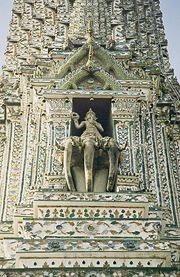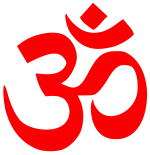Indra
| Indra | |
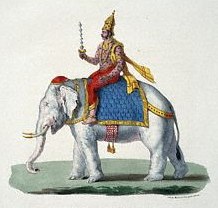 |
|
| weather and war, king of the gods | |
| Devanagari | इन्द्र or इंद्र |
|---|---|
| Affiliation | Deva |
| Abode | Amarāvati in Svarga |
| Weapon | Vajra |
| Consort | Sachi/Indrāṇi |
| Mount | Airavata |
Indra (Sanskrit: इन्द्र or इंद्र Indra, Malay: Indera, Thai: พระอินทร์ Phra-Intra, Japanese: Taishakuten) is the god of War and Weather, also the King of the gods or Devas and Lord of Heaven or Svargaloka in Hinduism. Mentioned first as the chief deity in the sacred Hindu text of Rig Veda, Indra is bestowed with a heroic and almost brash and amorous character. He has always remained significant in Indian mythology, from Vedic to Puranic times, as the primary ruler of all devas, even as his reputation and role diminished in later Hinduism with the rise of the Trimurti. However he is still active in the Pali canon, where he is addressed as Sakka (from Sanskrit Śakra).[1]
Contents |
Origins
Indra is attested as a god of the Mitanni. If Devendra (Indra) as a deity is cognate to other Indo-European gods, either thunder gods such as Thor, Perun, or Zeus, or heroic gods such as Mars, or gods of intoxicating drinks such as Dionysos, his name has either not been preserved in any other branch, or else it is itself an Indian (or perhaps Indo-Iranian) innovation. Janda (1998:221) suggests that the Proto-Indo-European (or Graeco-Aryan) predecessor of Indra had the epitheta *trigw-welumos "smasher of the enclosure" (of Vritra, Vala) and diye-snūtyos "impeller of streams" (the liberated rivers, corresponding to Vedic apam ajas "agitator of the waters"), which resulted in the Greek gods Triptolemos and Dionysos.
In the religious practices of the foundation of Hinduism, q.e. Vedic civilization, Indra has prominence over the continuation of chief god of the Indo-European pantheon Dyēus (Dyēus appears in the Vedas as Dyaus Pita, a relatively minor deity who, interestingly, is the father of Indra). Compare to this the relatively low status of Tyr compared to Odin or Thor in Norse paganism.
It was once supposed that Vedic Indra corresponds to Verethragna of the Zoroastrian Avesta. This idea was based primarily on the fact that the noun verethragna- corresponds to Vedic vrtrahan-, which is predominantly an epithet of Indra. The supposition that Indra corresponds to Verethragna is now obsolete. While both vritra- and verethra- derive from the same root "to cover", the word verethra- is today understood to mean "obstacle". Thus, verethragna- is now understood to reflect "smiter of resistance". Vritra does not appear in either the Avesta or in 9th-12th century books of Zoroastrian tradition. The name 'Indra' appears in Zoroastrian texts as that of an arch-demon opposing Truth (Vd. 10.9; Dk. 9.3; Gbd. 27.6, 34.27).
In the Rig Veda
The Rig-Veda states,
He under whose supreme control are horses, all chariots, the villages, and cattle;
He who gave being to the Sun and Morning, who leads the waters, He, O men, is Indra. (2.12.7, trans. Griffith)
It further states,
“Indra, you lifted up the outcast who was oppressed, you glorified the blind and the lame.” (Rg-Veda 2:13:12)[2]
Indra is the chief god of the Rigveda (besides Agni). He delights in drinking Soma, and the central Vedic myth is his heroic defeat of Vritra, liberating the rivers, or alternatively, his smashing of the Vala, a stone enclosure where the Panis had imprisoned the cows, and Ushas (dawn). He is the god of war, smashing the stone fortresses of the Dasyu, and invoked by combatants on both sides in the Battle of the Ten Kings.
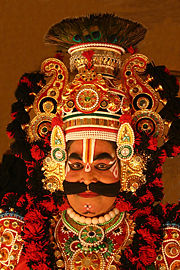
The Rig-Veda frequently refers to him as Śakra: the mighty-one. In the Vedic period, the number of gods was assumed to be thirty-three and Indra was their lord. (The slightly later Brihad-aranyaka Upanishad enumerates the gods as the eight Vasus, the eleven Rudras, the twelve Adityas, Indra, and Prajapati). As lord of the Vasus, Indra was also referred to as Vāsava.
By the age of the Vedanta, Indra became the prototype for all lords and thus a king could be called Mānavendra (Indra or lord of men) and Rama, the hero of the Ramayana, was referred to as Rāghavendra (Indra of the clan of Raghu). Hence the original Indra was also referred to as Devendra (Indra of the Devas). However, Sakra and Vasava were used exclusively for the original Indra. Though, modern texts usually adhere to the name Indra, the traditional Hindu texts (the Vedas, epics and Puranas) use Indra, Sakra and Vasava interchangeably and with the same frequency.
"Of the Vedas I am the Sama Veda; of the demigods I am Indra, the king of heaven; of the senses I am the mind; and in living beings I am the living force [consciousness]." (Bhagavad Gita 10.22) [1]
Status and function
Indra is an important god in many Hindu mythological tales. He leads the Devas (the gods who form and maintain Heaven) and the elements, such as Agni (Fire), Varuna (Water) and Surya (Sun)), and constantly wages war against the demonic Asuras of the netherworlds, or Patala, who oppose morality and dharma. He thus fights in the timeless battle between good and evil. As the god of war, he is also regarded as one of the Guardians of the directions, representing the east. He is however, not a perfect being, and is ascribed with more human characteristics and vices than any other Vedic deity. Perhaps consequently, he also has the most hymns dedicated to him: 250 (Masson-Oursel and Morin, 326).
Modern Hindus, however tend to see Indra as minor deity in comparison to others in the Hindu pantheon, such as Shiva, Vishnu, or Devi. A Puranic story illustrating the subjugation of Indra's pride is illustrated in the story of Govardhan hill where Krishna, avatar or incarnation of Vishnu carried the hill and protected his devotees when Indra, angered by non-worship of him, launched rains over the village.
Characteristics
In Rig Veda, Indra the solar god is sometimes described as golden-bodied ("Gora" that means golden-yellowish-reddish) with golden jaw, nails, hair, beard.
"In Indra are set fast all forms of golden hue."[3]
"At the swift draught the Soma-drinker waxed in might, the Iron One with yellow beard and yellow hair." The Rig Veda/Mandala 10/Hymn 96
"Fair cheeks hath Indra, Maghavan, the Victor, Lord of a great host, Stormer, strong in action. What once thou didst in might when mortals vexed thee, where now, O Bull, are those thy hero exploits?" (RigVeda, Book 3, Hymn XXX: Griffith)[4]
"May the strong Heaven make thee the Strong wax stronger: Strong, for thou art borne by thy two strong Bay Horses. So, fair of cheek, with mighty chariot, mighty, uphold us, strong-willed, thunderarmed, in battle." (RigVeda, Book 5, Hymn XXXVI: Grffith)[5]
Indra's weapon, which he used to kill Vritra, (with the help of other gods), is the thunderbolt (Vajra), though he also uses a bow, a net, and a hook. He rides a large, four-tusked white elephant called Airavata. When portrayed having four arms, he has lances in two of his hands which resemble elephant goads. When he is shown to have two, he holds the Vajra and a bow .[6]
Indra lives in Svarga in the clouds around Mt. Meru. Deceased warriors go to his hall after death, where they live without sadness, pain or fear. They watch the Apsaras and the Gandharvas dance, and play games. The gods of the elements, celestial sages, great kings, and warriors enrich his court.
"Indradhanush", the bow of Indra: Rainbow
In Hindu mythology, the rainbow is called "Indradhanush", meaning the bow (Sanskrit & Hindi: dhanush is bow) of Indra, the God of lightning, thunder and rain.
Relations with other gods
He is married to Indrani (whose father, Puloman, Indra killed), and is the father of Arjuna (by Kunti), Jayanta, Midhusa, Nilambara, Khamla, Rbhus, Rsabha. Indra is also the father of Vali and brother to Surya. He is attended to by the Maruts (and the Vasus), children of Diti (mother of demons), and Rudra. Indra had slayed Diti's previous wicked children, so she hoped her son would be more powerful than him and kept herself pregnant for a century, practicing magic to aid her fetal son. When Indra discovered this, he threw a thunderbolt at her and shattered the fetus into 7 or 49 parts; each part regenerated into a complete individual, and the parts grew into the Maruts, a group of storm gods, who are less powerful than Indra.
Indra and Vritra
Vritra, an asura, stole all the water in the world and Indra drank much Soma to prepare himself for the battle with the huge serpent. He passed through Vritra's ninety-nine fortresses, slew the monster and brought water back to Earth.
In a later version of the story, Vritra was created by Tvashtri to get revenge for Indra's murder of his son, Trisiras, a pious Brahmin whose increase of power worried Indra. Vritra won the battle and swallowed Indra, but the other gods forced him to vomit Indra out. The battle continued and Indra fled. Vishnu and the Rishis brokered a truce, and Indra swore he would not attack Vritra with anything made of metal, wood, or stone, nor anything that was dry or wet, or during the day or the night. Indra used the foam from the waves of the ocean to kill him at twilight.
In yet another version, recounted in the Mahabharata, Vritra was a Brahmin who got hold of supernatural powers, went rogue and became a danger to the gods. Indra had to intervene, and slew him after a hard fight. A horrible goddess named Brāhmanahatya (the personified sin of Brahmin murder) came from the dead corpse of Vritra and pursued Indra, who hid inside a lotus flower. Indra went to Brahma and begged forgiveness for having killed a Brahmin. "Vajrayudha" which Indra possessed is believed to be prepared from backbone of a sage Dadhichi to kill Asuras.
Ahalya's curse
Indra duped Ahalya, the wife of Gautama Maharishi, into letting him have sex with her. He was punished by Gautama with a curse that one thousand vaginas would cover his body in a grotesque and vulgar display, and that his reign as king of the gods would meet with disaster and catastrophe.[2] Gautama later commuted the curse, upon the pleading of Brahma, to one thousand eyes instead.
Due to this sin Indra's throne is supposed to remain insecure forever. He is repeatedly humiliated by demonic kings like Ravana of Lanka, whose son Indrajit (whose name means victor over Indra) bound Indra in serpent nooses and dragged him across Lanka in a humiliating display. Indrajit released Indra when Brahma convinced him to do so in exchange for celestial weapons, but Indra, as the defeated, had to pay tribute and accept Ravana's supremacy. Indra realized the consequences of his sin, and was later avenged by the Avatara of Vishnu, Rama, who slew Ravana to deliver the three worlds from evil, as described in the epic Ramayana.
However, according to the tradition of the temple of Suchindrum, near Nagercoil, in Southern Tamil Nadu, Indra was promised relief from the curse, if he could manage to worship the Divine Trinity of Hinduism, Brahma, Vishnu and Shiva simultaneously. This he succeeded in doing at Suchindrum, where the presiding deity is Sthanumalayan, a combined form of Shiva (Sthanu), Vishnu (Mal) and Brahma (Ayan), and was accordingly granted relief. Tradition maintains that he continues to worship each night at the temple, on account of which the priests of the temple, on appointment, are made to take a vow in Tamil "Aham kaṇdathai puram çolla mattān", meaning "I will never reveal anything I see within". Further, part of their duty is to clean the sanctum sanctorum of the temple and leave it ready for all rituals at night before closing the temple and clean it again, when they re-open it in the morning.
- See also: Rukmangada, Tulsi
Indra and the Ants
In this story from the Brahmavaivarta Purana,[7][8] Indra defeats Vritra and releases the waters. Elevated to the rank of King of the gods, Indra orders the heavenly craftsman, Vishvakarma, to build him a grand palace. Full of pride, Indra continues to demand more and more improvements for the palace. At last, exhausted, Vishvakarma asks Brahma the Creator for help. Brahma in turn appeals to Vishnu, the Supreme Being.
Vishnu visits Indra's palace in the form of a brahmin boy; Indra welcomes him in. Vishnu praises Indra's palace, casually adding that no former Indra had succeeded in building such a palace. At first, Indra is amused by the brahmin boy's claim to know of former Indras. But the amusement turns to horror as the boy tells about Indra's ancestors, about the great cycles of creation and destruction, and even about the infinite number of worlds scattered through the void, each with its own Indra. The boy claims to have seen them all. During the boy's speech, a procession of ants had entered the hall. The boy saw the ants and laughed. Finally humbled, Indra asks the boy why he laughed. The boy reveals that the ants are all former Indras.
Another visitor enters the hall. He is Shiva, in the form of a hermit. On his chest lies a circular cluster of hairs, intact at the circumference but with a gap in the middle. Shiva reveals that each of these chest hairs corresponds to the life of one Indra. Each time a hair falls, one Indra dies and another replaces him.
No longer interested in wealth and honor, Indra rewards Vishvakarma and releases him from any further work on the palace. Indra himself decides to leave his life of luxury to become a hermit and seek wisdom. Horrified, Indra's wife Shachi asks the priest Brihaspati to change her husband's mind. He teaches Indra to see the virtues of both the spiritual life and the worldly life. Thus, at the end of the story, Indra learns how to pursue wisdom while still fulfilling his kingly duties.
The 14 Indras
Each Manu rules during an eon called a Manvantara. 14 Manvantaras make up a Kalpa, a period corresponding to a day in the life of Brahma. Every Manvantara has 1 Indra that means with every Kalpa 14 Indras changes. Thae Markandye Rishi is said to have a complete age of one Kalpa and in a Puran on his name called "Markandey Puran" the exact age corresponding to the human age or solar year is described in details. The following list is according to Vishnu Purana 3.1–2):
| Manvatara/Manu | Indra |
|---|---|
| Svayambhuva | Yajna (Avatar of Vishnu) |
| Swarochish | Vipaschit |
| Uttam | Sushaanti |
| Taamas | Shibi |
| Raivat | Vibhu |
| Chaakshush | Manojav |
| Shraaddhdev | Purandar (the present Indra) |
| Savarni | Bali |
| Daksha Saavarni | Adbhut |
| Brahma Saavarni | Shanti |
| Dharma Saavarni | Vish |
| Rudraputra Saavarni | Ritudhaama |
| Ruchi (Deva Saavarni) | Devaspati |
| Bhaum (Indra Saavarni) | Suchi |
In Buddhism, Jainism, and Chinese religion
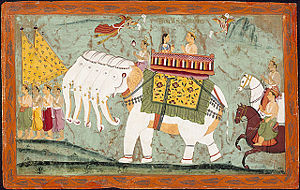
In Buddhist and Jain texts, Indra is commonly called by his other name Śakra, ruler of the Trāyastriṃśa heaven. Śakra is, however, sometimes given the title Indra, or, more commonly, Devānām Indra, "Lord of the Devas". The ceremonial name of Bangkok claims that the city was "given by Indra and built by Vishnukam." The provincial seal of Surin province in Thailand, is an image of Indra atop Airavata.
In Jainism, Indra is also known as Saudharmendra, he is always in duty towards Tirthankar's; most commonly referred with stories relating to Mahavira, Lord Indra himself manages and celebrates the five auspicious events in Tirthankar's life, such as Chavan kalyanak, Janma kalyanak, Diskha kalyanak, Kevalgyan kalyanak, and Nirvan kalyanak.
In China, Korea, and Japan, he is also known as 帝釈天, Taisha-cu-ten".
Some Buddhists have also even interpreted that the Taoist Jade Emperor is another interpretation of Indra.
See also
- Rigvedic deities
- Hindu deities
- Skanda
References
- ↑ Presidential Address W. H. D. Rouse Folklore, Vol. 18, No. 1 (Mar., 1907), pp. 12-23: "King of the Gods is Sakka, or Indra"
- ↑ "Indra and Shiva" by KOENRAAD ELST
- ↑ Hymn XXX, P. 407 The Hymns of the Atharvaveda
- ↑ Rig Veda: Rig-Veda, Book 3: HYMN XXX. Indra
- ↑ Rig Veda: Rig-Veda, Book 5: HYMN XXXVI. Indra
- ↑ (Masson-Oursel and Morin, 326).
- ↑ Zimmer, Myths and Symbols in Indian Art and Civilization, ed. Joseph Campbell (New York: Harper Torchbooks, 1962), p. 3-11
- ↑ webadept-ga, "Re: Religion and Suffering," 07 Jan 2003 21:26 PST, Google Answers, 28 March 2007 <http://answers.google.com/answers/threadview?id=138918>
- Masson-Oursel, P.; Morin, Louise (1976). "Indian Mythology." In New Larousse Encyclopedia of Mythology, pp. 325-359. New York: The Hamlyn Pulishing Group.
- Janda, M., Eleusis, das indogermanische Erbe der Mysterien (1998).
External links
- Indra, the Storm-god - by Benjamin Slade
|
||||||||||||||
|
|||||||||||||||||
